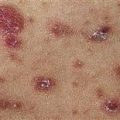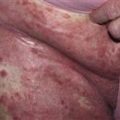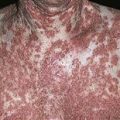57
Pubic lice
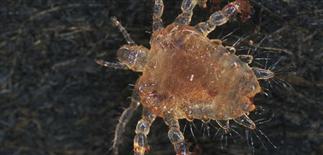
Phthirus pubis (pubic or crab louse), with a short, oval body and prominent claws resembling those of sea crabs.
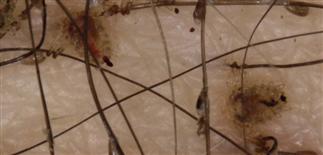
Small crab lice having a blood meal with additional nits attached to pubic hair shafts.
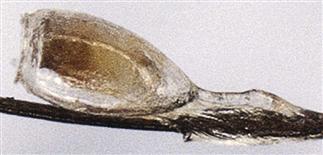
Nit attached to hair shaft. Hard white concretions which contain lice egg. Very difficult to remove.
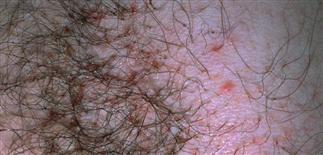
Pubic lice infestation. Difficult to see individual parasites without magnification. Inflamed bite marks or purpuric macules are diagnostic clues.
DESCRIPTION
Caused by infestation with Phthirus pubis. The most contagious sexually transmitted disease. The chance of acquiring pubic lice from an infested partner is more than 90%. Direct contact with an infected human is the primary source of transmission.
HISTORY
• Fomite transmission from hats, brushes, and earphones is common. • Most patients complain of pruritus. • Many patients are aware that something is crawling on the groin but are unfamiliar with the disease and have never seen lice. • Up to 30% of patients infested with pubic lice have at least one other sexually transmitted disease. • Infested adults may spread pubic lice or crab lice to the eyelashes of children. Crab lice infestation in children should be considered sexual abuse.
PHYSICAL FINDINGS
• Nits may be noticed before the lice. Nits, or lice eggs, are firmly cemented to hair shafts. • Lice may be difficult to see with close inspection or magnification. • The pubic hair is the most common site of louse infestation, but lice frequently spread to the hair around the anus. On hairy persons, lice may spread to the upper thighs, abdominal area, axillae, chest, beard. Occasionally, gray-blue macules (maculae ceruleae), varying in size from 1–2 cm, are seen in the groin and at sites distant from the infestation. Their cause is unknown, but they may represent altered blood pigment. • Most infected patients have very little if any inflammatory changes, but those who delay seeking help may develop widespread inflammation and infection of the groin with regional adenopathy.
TREATMENT
Topical medication
• An over-the-counter (OTC) permethrin rinse 1% is often the drug of first choice. It is applied and washed off after 10 min. OTC synergized pyrethrin shampoos are also used. Permethrin 5% is prescribed when OTC treatment fails. It is left on the hair overnight. • Lindane shampoo is left in for 5 min then washed out; treatment is repeated in 1 week. It is used if OTC treatment fails. Lindane-resistant lice have emerged. • Malathion lotion is highly effective. It is applied to dry hair and shampooed out after 8–12 h. All agents attack the louse’s nervous system; however, young nits are unaffected. Repeat treatment in 1 week.
Oral medication
• Ivermectin 200 µg/kg is given in a single oral dose that is repeated in 10 days. • Ivermectin attacks invertebrate nerve and muscle cells in the louse and causes paralysis and death. It has selective activity against parasites but no systemic effects on mammals.


